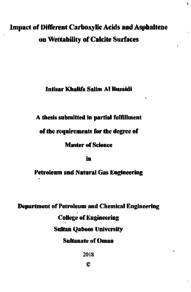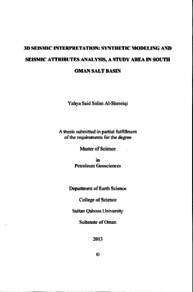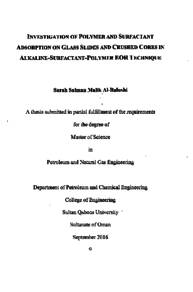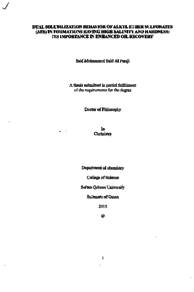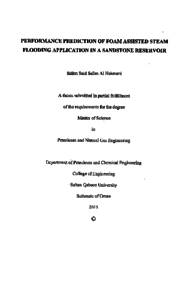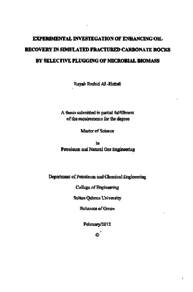Document
Impact of different carboxylic acids and asphaltene on wettability of calcite surfaces
Publisher
Sultan Qaboos University
Gregorian
2018
Language
English
Subject
English abstract
The average oil recovery by conventional water flooding from carbonate reservoirs is often less than 30%. As most of these reservoirs are fractured and oil-wet, injected water displaces the oil in the fractures, however the oil in the matrix blocks remains un-swept. Negative capillary pressure prevents water from penetrating through the oil-wet matrix. An effective approach to overcome the capillary pressure barrier to enhance oil recovery is altering wettability of the rock towards preferentially water-wet state. Removal of adsorbed acidic components and/or asphaltenes from the carbonate surface results in
wettability alteration towards water-wet state. In order to remove the adsorbed carboxylate and/or asphaltenes from the rock surface effectively and efficiently during enhanced oil recovery (EOR) processes, a clear understanding of the adsorption mechanism as well as the contribution of different crude oil compounds on the surface wettability is crucial.
Long chain fatty acids, long chain naphthenic acids and asphaltene are the major components in crude oil which are responsible for wettability alteration in carbonate reservoirs. In this study, different types of carboxylic acids and asphaltene were used as polar organic compounds in crude oil. Different analytical tools (contact angle, zeta potential measurement and thermal analysis) were utilized to study the effect of carboxylic acids and asphaltene on calcite surface wettability. The results indicated that polar organic
compounds act in different ways according to their structure and properties. Presence of double bond could make the acid molecule more polar, reactive and less hydrophobic. In addition, it can affect the spatial arrangement of molecule and hence its orientation on the surface. Presence of benzene ring increases the reactivity and polarity of carboxylic group. Moreover, it enhances hydrophilic properties of the acid due to electrons of it double bonds that can resonate over aromatic carbon atoms. The results revealed that, in the presence of water film, combination of acid dissociation in water, surface activity of acid and water solubility controls the acid adsorption and hence wettability alteration of the surface during aging process. Chemisorption of carboxylic acids/ asphaltene changes the wettability of calcite surface. In addition to chemical adsorption, some acids adsorb physically on the surface. Physical adsorption of polar compounds may happen via hydrogen bonding between carboxylic groups and carbonate ions on the surface. Although physical adsorption is reversible and forms weak bonds between adsorbate and adsorbent, it may partially contribute to wettability alteration
Description
Thesis
Member of
Resource URL
Arabic abstract
متوسط نسبة استخراج النفط من مكامن النفط الكربونية باستخدام طرق الغمر بالماء التقليدية يقل عن 30% من كمية النفط الموجود في هذه المكامن. ويعود ذلك التصدعات والخواص الزيتية للصخور حيث يزيل الماء المحقون النفط الموجود في التصدعات ويبقى النفط في الكتل الصخرية بسب الضغط الشعري السالب الذي يمنع الماء من الوصول إلى الكتل الرطبة والزيتية. أحد الطرق الفعالة للتغلب على حاجز الضغط الشعري وتعزيز الاستخلاص النفطي هو تعديل ترطيب سطح الصخور إلى الطابع المائي من خلال إزالة المكونات الحمضية والأسفلتين من سطح الصخور. إزالة المركبات الكربوكسيلية الممتصة والأسفلتين من السطح الصخري بكفاءة وفعالية خلال عمليات الاستخلاص المعزز للنفط يتطلب الفهم الواضح لألية الامتصاص بالإضافة إلى مساهمة مركبات النفط المختلفة في تغيير خواص رطوبة السطح الأحماض الكربوكسيلية ذات السلسلة طويلة الهيكل والأسفلتين لهم تأثير واضح على الصخور الكربونية. في هذه الدراسة، تم اختيار أنواع مختلفة من الأحماض الكربوكسيلية وكذلك الأسفلتين كمركبات عضوية قطبية موجودة في النفط الخام. كما تم استخدام أدوات تحليلية مختلفة (قياسات زوايا التماس السطحي، قياسات زيتا والتحليل الحراري) لدراسة تأثير الأحماض الكربوكسيلية والأسفلتين على رطوبة سطح الكالسيت. تشير النتائج إلى أن المركبات العضوية القطبية تعمل بطريقة مختلفة وفقا لهيكلها وخواصها. وجود رابطة مزدوجة في الأحماض الكربوكسيلية تجعلها أكثر قطبيه وتفاعلية واقل ميلان للخواص الزيتية. بالإضافة الى تأثيرها على الترتيب الموضعي على سطح الكالسيت. وجود حلقات البنزين في البنية الحمضية يزيد من فعاليتها وقطبيتها ويعزز من الخصائص المحبة للماء بسبب وجود الإلكترونات من الروابط الثنائية التي تعيد ترتيب نفسها في المركبات العطرية. أوضحت النتائج أنه في وجود الماء وقدرة الحمض على التفكك وذوبانه في الماء فإن النشاط السطحي اللحمض يتحكم في امتصاص الحمض وبالتالي تغيير قابلية السطح للرطوبة خلال عملية التغيير.
يغير الامتصاص الكيميائي للأحماض الكربوكسيلية والأسفلتين قابلية الترطيب لسطح الكالسيت. بالإضافة إلى الامتصاص الكيميائي، بعض الأحماض تمتص فيزيائيا على السطح. قد يحدث الامتصاص الفيزيائي للمركبات القطبية عن طريق الترابط الهيدروجينی پین مجموعات الكربوكسيل وأيونات الكربونات على السطح. على الرغم من أن الامتصاص الفيزيائي عكسي ويشكل روابط ضعيفة بين الممتص والماء، إلا أنه قد يساهم جزئية في تغيير قابلية الترطيب.
يغير الامتصاص الكيميائي للأحماض الكربوكسيلية والأسفلتين قابلية الترطيب لسطح الكالسيت. بالإضافة إلى الامتصاص الكيميائي، بعض الأحماض تمتص فيزيائيا على السطح. قد يحدث الامتصاص الفيزيائي للمركبات القطبية عن طريق الترابط الهيدروجينی پین مجموعات الكربوكسيل وأيونات الكربونات على السطح. على الرغم من أن الامتصاص الفيزيائي عكسي ويشكل روابط ضعيفة بين الممتص والماء، إلا أنه قد يساهم جزئية في تغيير قابلية الترطيب.
Category
Theses and Dissertations

